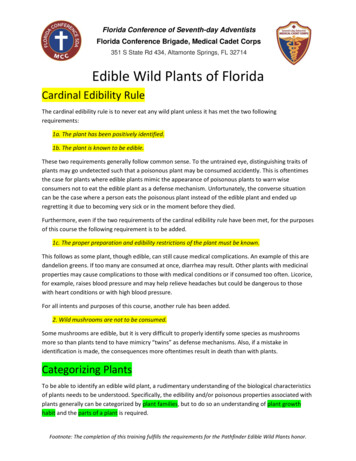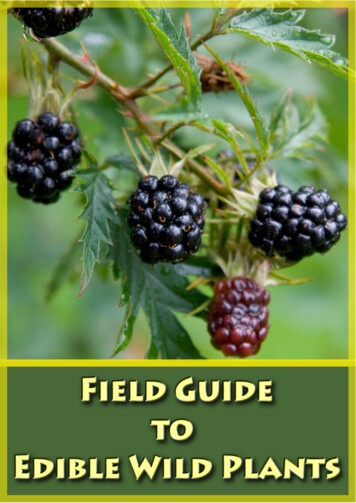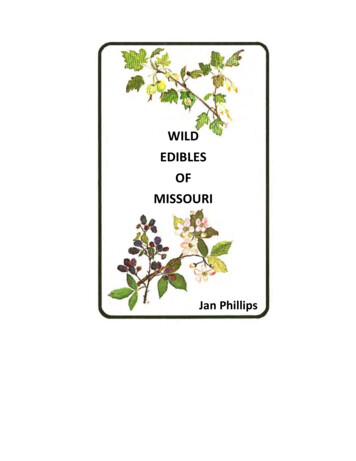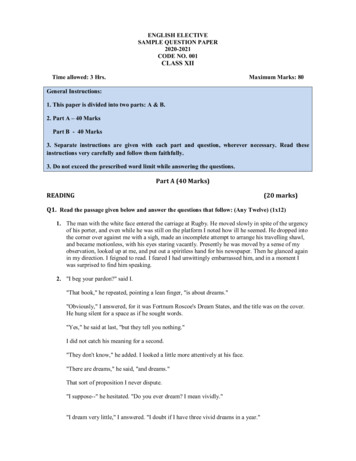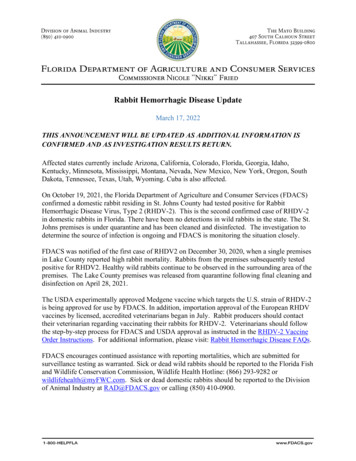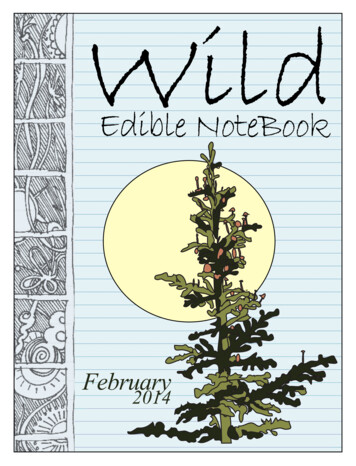
Transcription
WildEdible NoteBookFebruary2014
Hi and thanks so much forchecking out the Wild EdibleNotebook, a monthly collection ofstories about foraging and usingedible wild foods.WildEdible NoteBookManaging Editor:WFGCopy Editor:Gregg DavisContributor:Wendy PettyPhotography:Gregg DavisWendy PettyInfo:www.wildfoodgirl.comSocial Media:Instagram: wild.food.girlFacebook: wildfoodgirlContact:erica@wildfoogirl.comThis issue is all about conifers.First we head deep into a snowy,windblown landscape to collectwinter needles dropped by tallpines, spruces, and firs, afterwardsEating wild snow. Photoby Gregg Davis.exploring what to do with them inthe kitchen. Then we take a lookat another conifer—the low-lying common juniper and itscousins—and use the flavorful, ripe “berries” to seasonvarious dishes. There is a review of Jennifer Hahn’s PacificFeast, which centers on foraging the coast and forests of thePacific Northwest, and this edition concludes with a handfulof fun recipes using conifer needles by yours truly andWendy Petty from Hunger & Thirst.2022 Update:Begun as a free publication in 2011, the Wild EdibleNotebook was available by subscription from 2014-2015.It went on hiatus after that so I could undertake otherpursuits, chief among them a book I am writing.This year, I decided to start reissuing the Notebooks, aprocess that involves reading through and correcting anyglaring errors. I will admit that my thinking has evolvedon some topics since then, but for the most part I have notrewritten any stories.For current writing, please visit my blog at wildfoodgirl.com, or social media at Facebook (wildfoodgirl) andInstagram (wild.food.girl), where I post regularly.Sincerely,—WFG2
Contents:Foraging Conifers inthe Winter SnowNeedles Yew Don’tWant to EatJuniperusDeliciousnessWild Edibles fromCoast to Forest:Jennifer Hahn’sPacific FeastRecipes:Pine, Spruce, & FirNeedlesNature puts Fibonacci spiralsin all sorts of places.3
REVISED 2.8.22Copyright 2013 Erica M. Davisaka “Wild Food Girl”Text & photos by Erica M. Davis unless otherwiseindicated.All rights reserved, including the right ofreproduction in whole or in part in any form.While the author has prepared this Notebook tothe best of her ability, users should take necessaryprecautions including referencing multiple guidebooks prior to consuming wild plants. The stories inthis Notebook may not be applicable to your locale.Consult with a professional when appropriate.The author shall not be held accountable forwhat you choose to consume.Please email corrections toerica@wildfoodgirl.com.For more information,please visit:wildfoodg rl.com
Foraging Conifers in the Winter SnowThis is the winterof avalanches inthe Colorado highcountry—so muchsnow, as was to beexpected after ourbetter-than-normalmushroom seasonlast fall, but a ton ofwind too. As a result,normally stable slopesare sliding, steppingdown into older snowto produce avalancheswhere the crownsexceed 10 feet inheight and there’sdebris the size ofVolkswagens even inbounds at the ski areawhere I live and work.The inclementweather does notbother me. I like tostand on the mountainand let the strong windsbuffet me, especiallywhen the visibilityapproaches zero andthe slopes empty ofthose unwilling to bearnature’s brute force.These are the days I lose myself deep in the forest,under the protection of the conifers where theBy WFGMajestic conifers bestow gifts of needles in theheart of winter. Photo by Gregg Davis.5
world is soft and silent, to appreciate raremoments of solitude.But the winds have done something else,too—and that is to knock boughs of spruce,pine, and fir to the forest floor. Everywhere Iventure now, it seems, there are felled greenneedles for the taking. This coincides perfectlywith what is now a several-months-dormantobsession with wild food foraging—so thisseason I’ve made it my mission to gather anysevered branches I come upon, and recyclethem into wild food experiments.I realize the dead of winter is not the besttime to gather conifer needles. Spring andearly summer, when the fast-growing tips arenew and young, is preferable. Nonetheless, theneedles of edible conifers can be used yearround for a tea rich in Vitamin C, and teas canbe used for a variety of culinary purposes too,like stocks and broths for soups and gravies.So, I figured I’d give conifer needles a go.“Trees are the alphabet,” my friend,wild food expert Sam Thayer,wrote to me awhileAbove: A grove of lodgepole pinesdeep in the forest, off the beaten path.Below: An early January slide in thenew Peak 6 terrain. See the size of thecrown and the debris below.6
back. “Learn conifers first.” Funny how longit has taken me to do so, especially whenyou consider that certain mushrooms I adorecohabitate with certain species of trees.But now, deep in this snowy wonderland inthe heart of winter, I find myself stopping andremoving my gloves to roll needles between myfingers in the frigid air, and digging deep holesin the snow in search of cones to help positivelyID the conifers on my mind.Above: Chopped lodgepole pine needles.Below: Lodgepole pine needles come sheathedtogether in groups of two, wrapped at the basewith a thin membrane.country Colorado, as are limber pines (P.flexilis) and ancient bristlecone pines (P.aristata), both of which bear needles in groupsof five. Pinyon pines (P. edulis), famous fortheir edible seeds or pine nuts, have two-PinesThe pines are easiest, as the needles comesheathed together in groups of two or more,wrapped at the base with a thin membrane.The straight-trunked, two-needle lodgepolepines (Pinus contorta) are common here in high7
needle clusters and are found at slightly lowerelevations, and ponderosa pines (P. ponderosa),whose bark smells like vanilla to some andorange Creamsicles to others, bear long needlesin groups of two or three.Pine needles are rich in Vitamin C, and pineneedle tea is a well-known winter food use—asare teas made from the leaves of other Pinefamily members like spruces (Picea spp.), firs(Abies spp.), hemlock (Tsuga spp.) and Douglasfir (Pseudotsuga menziesii). Native groups haveused the needles of various conifers to make tea,both for hot drinks and remedies.“The needles may be used in tea as abeverage, or medicinally for a diuretic,”Thomas J. Elpel explains of the Pine family inBotany in a Day (2012 ed.). He also notesthat because the Pine family is resinous—andtherefore useful for its expectorant properties—overconsumption may lead to kidneycomplications. Thus “caution is advised,” hewrites. I took this to mean they’re probablynot teas to be drunk every day, or brewed inan extra high concentration. Also, due to theAbove: Gregg perches on a chunk of avalanchedebris. Below: More slides on Peak 6. Note thefractures where the slides let loose in TemptationBowl, a permanent terrain closure, at top left.8
diuretic effect, some folks report increasedthirst and having to pee a lot.Among the conifers, pines come with themost warnings—the most oft-cited of whichis that consumption of ponderosa pineneedles (P. ponderosa) has caused cattle toabort unborn fetuses (Stegelmeier, 1996). A1998 study by four of the five authors whoconducted the 1996 study found that pregnantcattle aborted their fetuses after being feddaily doses of lodgepole pine (P. contorta)needles too. For this reason, many authorsrecommend against taking conifer needles—particularly pine needles—internally duringpregnancy.However, since I am not with child and Ifound several references to teas made withlodgepole pine needles—and pinyon pineneedles—in Daniel Moerman’s online databaseof ethnobotanical resources (naeb.brit.org), Idecided to give the lodgepoles a try.Better Than Melted SnowAside from the fact that the pockets of mysnow pants are now sticky after stuffing so manyresinous needle-bearing branches into them, thetea was a mild success. I made it by choppinga handful of rescued lodgepole pine needles,pouring hot water overtop and covering themto steep a while. Though the flavor came outmellow, I decided not to boil it so as not to driveI was a little taken aback by the hydrophobic resinsfloating at the top of my lodgepole pine tea.9
off the heat-sensitive Vitamin C.Also, the online ethnobotaniescontain accounts of strong pineneedle decoctions being usedby some groups—for examplethe Navajo with pinyon pineneedles (Vestal, 1952)—as “aceremonial emetic,” in otherwords, as a vomit-inducer, aneffect I did not seek to replicate.I served a cup to Greggand he said it tasted fine, “likewinter,” which is better thansome of the accounts I’ve read.“With a squeeze of lemonand a little sugar it was almostenjoyable, and it gives agreat feeling of virtue to knowthat as you drink it you arefortifying your body with twoessential vitamins in which mostmodern diets are deficient,”Euell Gibbons writes of a cupof Eastern white pine needletea in Stalking the HealthfulHerbs (1970), touting boththe Vitamin C and VitaminA content with his less-thanconvincing flavor account.“I do make a tea from whitepine or hemlock needles inthe winter,” Thayer wrote me.“Usually just when I’m camping,so I haven’t in a few years. Itdoes taste better than meltedIced lodgepole pinetea with a squeeze oflemon, anyone?10
snow or lake water.”Personally, I was a little taken aback by thehydrophobic resins floating at the top of mytea. Elpel (2012) explains that plant resins are“sticky, gummy substances like pine pitch” thatare formed from oxidized volatile oils, often withexpectorant, diaphoretic, and diuretic properties.“Drink a warm tea of a resinous plant and yourthroat becomes coated with the sticky substance,”he writes. “It protects tissues from irritation whencoughing. Moreover, the stickiness seems to slickup the passageways in the body, so phlegm canbe more readily coughed up.”Fortunately, Gregg had managed to giveme his cold by the time I began the coniferneedle tea experiments, so even as my abilityto taste flavors declined, I could at least practiceexpectorating.My one major success with lodgepole pineneedles wasaccidental—afterchoppingthem fineand dousingthem with whatI thought was sugarsyrup, to which I planned toadd some of Gregg’s homebrewed kombucha for a pineysecond ferment, I discoveredthat the supposed sugar syrupwas in fact a wild angelicainfused liqueur I made overa year ago. So I went with itand let the pine needles infusein the angelica liqueur for 11days. This concoction came outsurprisingly good—delicious, in fact—whichsurprised me after reading a comment by Toddyat the BushcraftUK forum (www.bushcraftuk.com),who thought his attempt at pine needle vodkanot only unpleasant but “decidedly turpentineish.” (He ended up using it to clean grease offpine shelving.) Combined with the spicy, sweetangelica liqueur, however, the lodgepole needlestoned down the sweetness with a note of pinethat fit the liqueur perfectly—noticeable in agood way, and not overbearing in the least.“It’s hillbilly retsina,” my friend Aaron fromAustralia wrote me about one of my coniferneedle vodka infusions. Retsina, whichhe’d earlier described as a “phytochemicaladventure,” is a unique Greek wine fermentedwith Aleppo pine resin (Pinus halepensis). TheI spent a snow dayat home infusingwhite fir needles intovodka. The mixturecame out surprisinglyviscous, but workedwell chilled andsweetened.11
American Society of Pharmacognosydescribes it in their Fall 2007newsletter as “wine that has beenpoisoned with pine resin.” I guess Iwouldn’t recommend that—not pinenor wine—for pregnant women either.FirsMy second attempt at coniferneedle tea, made from the needlesof white fir (Abies concolor)—wasa breath of fresh, well—Christmastree. That’s because firs are amongthe conifers sold as Christmas trees,though it is important to note that acommercially grown tree is a riskychoice for tea-making unless youknow that the farm it came from didnot use pesticides.I found the tree in the middle ofa snowy forest on a steep, northfacing hillside—a young specimen,surrounded by tall Engelmann spruce.The flat needles were soft and pliablein comparison to the spruce, and thetips were still a lighter shade of greenthan the rest of the tree despite the factthat it was the middle of January.Not to be confused with Douglas fir(Pseudotsuga menziesii), which is ina different genus and has distinctivecones with three-pointed bracts thatextend beyond the cone scales, true firsTop: A subalpine fir with breakaway cones.Every time I tried to pick a full cone, thescales fell away, leaving these uprightcores. Right: White fir needle tea is myfavorite local conifer tea to date.12
(Abies spp.) bear upright cones whose scales fallaway, leaving an upright central core. Both whitefir, which has longer needles, and subalpine fir(Abies bifolia), which is sometimes lumped withA. lasiocarpa of the Pacific Northwest, occur inthe forests near me at 10,000 feet. The needlesof both are flat and sessile—meaning they attachdirectly to the branch—and do not narrow muchat their bases if at all.I enjoyed the fir tea a great deal, as did Gregg,so I decided to infuse vodka with its winterTop: More lovely fir needles, combinedwith dried rosehips and mint for awintertime tea blend (right).13
Top: Vinegar and vodka experiments with spruce andpine. Bottom: A mix of fragrant sumac powder, white firneedles, and salt makes a perfect seasoning for squashseeds. Photo by Gregg Davis.needles too, following the method described byConnie Green and Sarah Scott in The Wild Table(2010) for Douglas fir or spruce. The recipe callsfor blending a cup of needles, stripped from theirbranches, with a splash of vodka, then combiningthat with the rest of a 750-milliliter bottle of vodkaand infusing the mixture in the refrigerator for aweek before straining out the needles. The greenelixir can then be stored in the freezer and servedstraight up in a martini glass.My infusion came out so strong after oneday, however, and so viscous, that I strained14
the bits out then and there. Though the thick,syrupy texture is a little off-putting, the flavoris good. I disguised the viscosity with plentifulsugar syrup and served it as a Christmassyliqueur over crushed ice in tiny glassesalongside an hors d’oeuvre of juniper-accentedantelope liver pâté and crackers.Of all my experiments with local firs, myfavorite by far was a spice mix made with fresh,winter-foraged white fir needles, tart fragrantsumac (Rhus aromatica) berries, and sea salt,ground and sprinkled over trout and then ovenbaked (see page 39 for details). The spice mixwas equally good atop baked squash seeds.Gregg devoured both, and reminisced about thefish dish for days afterward.Spruce needles narrow into woody pegs thatattach to the branches.SprucesI also experimented with Engelmann spruce(Picea engelmannii) needles, as the trees arecommon up here in the subalpine zone. Sprucesare characterized by four-sided needles, or,as some authors write, needles that roll easilybetween the fingertips—whereas those of flatneedled firs do not. The leaves are borne singlyon stout wooden pegs where they attach tothe branches, and the light brown female seedcones hang down from the tree tops in clustersand have thin, flexible scales.I tried infusing vodka with mature needles of15
Engelmann spruce the same way I did with thefir. After one short day of infusing, however, Ifound the flavor so revolting that I spit it out inthe sink. Maybe there are better spruces forthe purpose, or perhaps the flavor would haveimproved had I infused it longer? In any case, Iabandoned that project.More successful were two infused applecider vinegars—an idea I got from aninterview by Lynne Rossetto Kasper withforager Nova Kim for The Splendid Table(www.splendidtable.org). I made both withEngelmann spruce needles, the first coarselychopped and the second ground fine in aspice grinder, and then let both sit in coveredjars in the closet for a week. Both came outgood, but the latter took on the spruce flavorbetter. Unlike the vodka, the apple cidervinegar did well to tone the harsh flavor ofthe spruce for a palatable vinegar, so I usedthat to make some tasty conifer-kissed salt andvinegar potato chips.We also have Colorado blue spruce (Piceapungens) up here. These are generally found inthe company of other species in moist locationsbelow the Engelmann spruce of the subalpinezone. The sharp, bluish-gray, four-sided needlesseem at first to be a giveaway for identification,though S. K. Weir (2011) indicates the twospruces may hybridize, and that Engelmannspruce can sometimes take on a bluish cast.Colorado blue spruce is a favorite of myforaging friend, Butter, who goes mad for theMe and an Engelmann spruce in the high country.16
fresh, soft new tips that grow from the branchends each spring. For her Spruce CornmealCake with Tangerine Goat Cheese Frosting,Spruce Tip Salt, and other recipes, check outhungerandthirstforlife.blogspot.com.Spring Conifer TipsI chose to write about the conifer needles I haveaccess to right now in the Colorado high country,but there are other species with edible needlesthat can be used for similar purposes. I also wroteabout winter needles, but tips of the branchesin spring and early summer—while they are stillyoung, soft, and light green or blue—are morepopular for culinary uses. Collectors recommendtaking the new tips from branches low-down onthe tree, spreading out the harvest to multipletrees, and never taking the middle apical tips soas to avoid stunting a branch’s growth. Tastetesting is also recommended, to ensure you’vefound a tree whose flavor appeals to you.More spruce, and more slides above it. I love how lowand scraggly these guys get at treeline.In terms of flavors to expect from spring tips,Nova Kim said in the interview: “Spruce isfrequently compared to rosemary. Balsam hasa tendency to pair better with sweets; it’s not asstrong and as intense as the spruce. The whitepine is the mildest. Then of course there’s myfavorite, which is the concolor, which is a crossbetween a lemon and an orange fresh zest.”In Pacific Feast (2010), Jennifer Hahn writesof using the new spring tips of Sitka spruce(Picea sitchensis) and Grand fir (Abies grandis)in various recipes, including a spruce syrup tobe drizzled “over lamb, wild game, roasted rootvegetables, baklava, cheesecake, fresh berries,and sourdough pancakes.”Other popular uses of spruce tips are sprucebeer and spruce jelly, though it merits mentionthat one of my FB friends experienced an allergic,hay-fever-style reaction to a batch of spruce tip17
jelly she made. For beer brewers who don’t wantto do the wild food foraging themselves, Spruceon Tap (www.spruceontap.com) sells sprucetips, yarrow, juniper “berries,” and other wildharvested natural ingredients. I’ve also read greatreviews of the Alaska-based Simple Pleasures’spruce tip jelly (www.simplepleasuresak.com).There is an intriguing recipe for Conifer Sugar atwww.kinfolk.com that involves combining equalparts needles with sugar, chopping in the foodprocessor, and sprinkling the flavored sugar onTasty, soft, spruce tips foraged in the Keystonearea last summer. I used them to make acreamy spruce and dill yogurt sauce.buttered toast or using it in place of sugar inshortbread or other cookies. And last summer Imade a yummy, pale green spruce and dill sauceto serve atop both salmon and asparagus bywhizzing up fresh spruce tips in a food processorwith yogurt and dill.18
Wandering Winter,Pining for SpringThe winter needlescertainly do well to satisfya craving, but now that Ihave made better friendswith our local conifers,I am looking even moreforward to spring, whenthe old denizens of theforest burst forth with theirsoft, light green bundlesof flavorful new needles.In the meantime, however,I’ll continue to meanderthrough the winter snows,tasting trees and dreamingof spring as I learn theforest’s winter landscapefrom a forager’s perspective.Surprise! Light green tips in the middle of winter. 19
Needles Yew Don’t Want to EatMake sure todistinguish Pine familymembers from yews(Taxus spp.), whichare toxic lookalikes.Though yews haveneedles too, they areNOT edible. Almostevery part—includingthe bark, leaves, andseeds—is poisonous.Yew needles aresofter, thicker, and widerthan other evergreens,similar to hemlock needles in shape butwithout the silvery lines underneath. They canbe difficult to distinguish from balsam.Imported varieties, like the Japaneseyew (T. cuspidata), are widely used inlandscaping. The bushes are often trimmedinto shapes, and the fruits are fleshy red cups.By WFGThese fleshy red cups are,in fact, edible if you spit outthe poisonous seeds, but Ihave not tried them yet.There are also nativeyews in the wild, includingthe American yew(T. canadensis) in thenortheastern quarter of theU.S., Florida yew(T. floridana), and Westernyew (T. brevifolia) on theWest Coast, so if Taxusspecies occur in yourregion, it is a good idea to learn thembefore embarking on a culinary adventurewith needle-bearing trees and shrubs.Above: The fleshy red berries are the only edible partsof yews, but you have to spit out the toxic seeds. Photoby Muffet, licensed for reuse under Creative Commons.Below: A yew in the landscaping in Pennsylvania.20
Juniperus DeliciousnessColorado’s highcountry forests arebeautiful, deep anddark and old, and wehave the conifer treesto thank for that—theplentiful pines, somberspruces, and furry firs.But there is anotherneedle-bearing coniferthat makes its homeon the forest floorbeneath the trees—their creeping cousin,common juniper(Juniperus communis).The conifers area fascinating group.They are often called“living fossils,” EuellGibbons explains inStalking the FarawayPlaces (1973), becausethey appeared onearth millions ofyears before the firstflowering plants, orangiosperms. Conifersare gymnosperms,which means “nakedseed.” The femalecones’ egg cells are exposed to the air to befertilized when pollen released by the smaller,male cones finds its way—via aerodynamicallyBy WFGCommon juniper cones look like blueberries. These make a good spice for gameand sauerkraut, among other dishes.21
produce the cones we all know and love, theirlayered scales radiating out from a central corein a whorled Fibonacci sequence common in somany of nature’s creations. But junipers, whichare members of the Cypress family, makecones of another sort. Whether spreading,spiny shrub like the common juniper whereI live, or tree with scaly foliage, junipersproduce cones with fleshy, merged scalesthat cause them to look like berries.Common JuniperA Fibonacci spiral ofscales make up thislarge cone.matched, species specific, cone-generated aircurrents—to its mark (Elpel, 2013 ed.). Afterfertilization, the female cones grow scales tocover the ovules as the seeds mature.Pine family members like spruce, pine, and firThe “berries” of common juniper (J. communis)are used to flavor gin, hence the gin-like aromawhen you crush them between your fingertips.They are used in various European cuisinesas spices—to flavor meat dishes, game, andsauerkraut, for example—and can be purchasedat the grocery store for the same purpose. Butthey can also be collected in the wild.Common juniper is found throughout thetemperate zone of the Northern Hemisphere,These cones, from common juniper, are very differentthan those produced by Pine family members.22
including Europe, Canada, and much of theUnited States, with the exception of Texas andsurrounding southern states.Our Colorado subspecies is J. communis L.subsp. alpina (Weber & Wittmann, 2012),a sprawling shrub that thrives in open spotsin the forest understory or on rocky, exposedhillsides. The needle-leaves are white above,green below, and sharp enough to give yourhands a good poke. The berries are blue topurple with a powdery whitish coat whenripe, or light green with a powdery coatwhen under-ripe.For years I have been using what I callJuniper tickling works, but you might be betteroff shaking the bush. Photo by Gregg Davis.“the tickle method” to collect the ripe berries,which involves rolling the clusters lightlybetween the fingers of one hand whilecatching them in the other, although I thinkConnie Green and Sarah Scott have me beatwith their suggestion to spread a tarp out inautumn and simply shake the bush (The WildTable, 2010). I have been using J. communisberries because this species is abundantwhere I live. However, it is not the onlyjuniper with edible berries.23
Which Junipers Can I Use?In addition to needle-bearing junipers,there are also junipers with scaly, triangularleaves pressed together onto the branches,some of which bear edible berries. Weberand Wittmann (2012) divide these cedar-likejunipers into a different genus, Sabina, whileother botanists include them in Juniperus.Here in Colorado, our tall, scaly junipersinclude Utah juniper (S. osteosperma syn. S.utahensis), which has dry, mealy berries andis found throughout the Southwest to Californiaand north to the Canadian border. We alsohave oneseed juniper (S. monosperma),which has liquid resin inside its berries, andthe high-elevation-loving Rocky Mountainjuniper (S. scopulorum) with small cones notexceeding 7 millimeters in diameter.Though I have not yet had occasion tocook with these species, Green Deane (www.eattheweeds.com) writes that the Acomapeople have been known to mix the berries of J.monosperma with chopped meat and then roastit all in a clean deer stomach; the Mescalero toroast them and add water to make a gravy; andthe Apache to boil the berries of J. osteospermaand eat them plain.A scaly-leaved, cedar-like juniper photographed in the dryfoothills near Rifle Gap State Park last summer.24
Moving east, TamaMatsuoka Wong(www.seriouseats.com)writes that the easternred cedar (Juniperusvirginiana), commonto the wilds of centraland eastern NorthAmerica, has berriesthat are “sweeterand less harsh”than J. communis,and “without those‘turpentine’ gin notes.”These have been usedby the Comancheand Lakota in soups,meats, and stews,she explains, and thetrees are often foundpioneering in oldCommon juniper covers the ground in Fairplay,hedgerows and fields.Colorado.Photographed in September, when theGreen Deane lists numerous junipers usedberries were ripe for the picking.by native groups, including J.californica, J. communis, J. deppeanasyn. J. pachyphlaea, J. horizontalis,Threatened & Endangered JunipersJ. monosperma, J. occidentalis, J.Although no junipers are listed as protected by theosterosperma syn. J. utahensis, J.federal government, some are listed as threatened,scopulorum, J. tetragona, J. virginianaendangered, or otherwise protected on a state-by-stateand J. silicicola. Elsewhere, he writes,basis. Common juniper is listed as rare, threatened, orthe berries of these junipers haveendangered in Illinois, Indiana, Maryland, Ohio, andbeen used: J. tetragoan (Mexico) J.Kentucky. J. horizontalis is protected in Illinois, Iowa,bermudiana (Bermuda), J. drupaceaNew Hampshire, New York, and Vermont. In Nevada,(Europe and the Middle East), J.all junipers appear to be “protected as a cactus, yucca,chinensis, J. conferta, J. recurva, andor Christmas tree.” For more state-by-state informationJ. rigida in Asia.on protected species, including the coniferous treesHowever, he cautions that notdescribed in the first piece, see plants.usda.gov.all junipers bear edible berries,25
advising specifically against using J. sabinaand J. oxycedrus, both from southern Europe.The former is often planted as an ornamentalin the United States, he explains, so carefulidentification is advised when harvesting fromlandscaping plants. That said, Green and Scottwrite that some junipers used in landscaping—including the common juniper J. communis andalso J. chinensis, have flavorful, edible berries.Deane points out too that while the foliageof some junipers, like J. communis, can beused, the foliage of J. virginana, J. silicicola,J. sabina, and J. oxycedrus should not beconsumed. Elpel (2013) also writes of theDried common juniper berries grind down intoa sweet, mustard-colored spice. How manytablespoons is too many, do you think?toxicity of J. sabina, concluding: “As a rule, ifit tastes like food it probably is. If it tastes liketurpentine, limit your consumption.”Eat Spices & Self-Medicatein ModerationEven junipers with “edible” berries comewith warnings, however. Kershaw (2000)cautions ominously that large and/or frequentdoses of juniper can result in convulsions,26
kidney failure, and an irritated digestive tract.“People with kidney problems and pregnantwomen should never take any part of juniperinternally,” she concludes, as do many authors.The same volatile oil that that irritatesthe kidneys in large doses can be usedmedicinally to stimulate kidney filtrationand output, however, which is why juniperberries have been used as a diuretic toincrease urine output and relieve symptomsof gout and kidney stones, as explained ina Forestry Department paper by the Foodand Agriculture Organization of the UnitedNations (FAOUN, 1998).The volatile oils can also kill germs, Elpeladds (2012), citing Bigfoot. “You may beable to decrease the risk of catching a virusby keeping juniper berries in the mouth whilearound others who are infected. Similarly, trychewing the berries while drinking uncleanwater,” he writes.“As with many herbs used medicinally oras a spice, juniper berries should be usedsparingly,” Green Deane concludes. “Thinkflavoring, not food.”I served Gregg these lovingly prepared crackerswith juniper-spiced antelope liver pâté, hard-boiledegg slices, and tomato. He pretended to like them.Personally, I couldn’t get enough.27
Flavoring FoodI probably should have taken Deane’s adviceto heart recently when I over-spiced a batch ofantelope liver pâté. Not that I experienced anyill effects—but two tablespoons of dried, groundcommon juniper berries was one tablespoon toomany for the pâté—which I made with
Feb 02, 2022 · Instagram: wild.food.girl Facebook: wildfoodgirl Contact: erica@wildfoogirl.com Wild Edible NoteBook Hi and thanks so much for checking out the Wild Edible Notebook, a monthly collection of stories about foraging and using edible wild foods. This issue is all about conifers. First

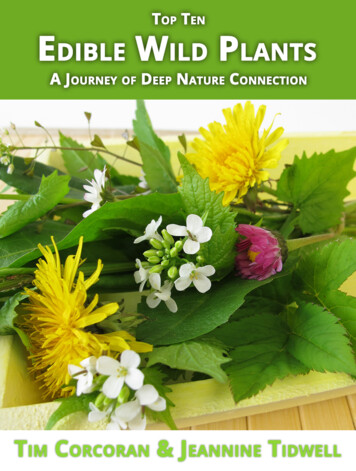
![INDEX [randycherry ]](/img/21/x-20-20tv-20fakebook-20-20hal-20leonard.jpg)

